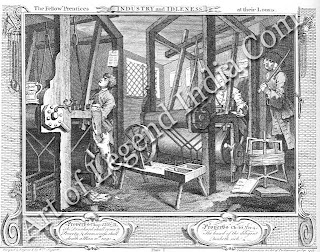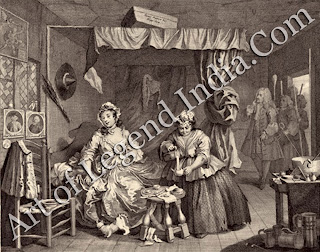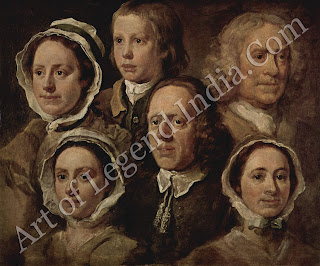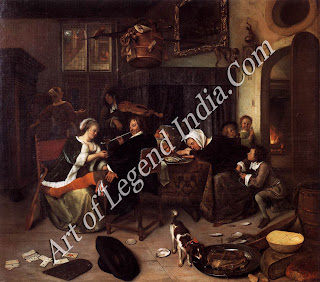 Although
he established himself primarily as an engraver, Hogarth also tried his hand at
other, more traditional, genres of art. He tried portraiture, the fashionable
'conversation pieces', decorative mural painting, and religious and
'Historical' painting. But although successful in these fields, he worked at
them as if to prove he could do them, and in order to give potential patrons
the opportunity to commission such works from him and from other British
artists should they wish to do so. His theoretical treatise, The Analysis of
Beauty in which he argued that beauty
resided in a kind of serpentine line was in part serious, in part mockery of
what he called 'the puffers in books' and in part self-mockery.
Although
he established himself primarily as an engraver, Hogarth also tried his hand at
other, more traditional, genres of art. He tried portraiture, the fashionable
'conversation pieces', decorative mural painting, and religious and
'Historical' painting. But although successful in these fields, he worked at
them as if to prove he could do them, and in order to give potential patrons
the opportunity to commission such works from him and from other British
artists should they wish to do so. His theoretical treatise, The Analysis of
Beauty in which he argued that beauty
resided in a kind of serpentine line was in part serious, in part mockery of
what he called 'the puffers in books' and in part self-mockery.
Hogarth's
perceptive portrayal of character and his bitingly satirical commentary on
18th-century life earned him comparison with Shakespeare England's greatest
student of the human comedy.
Everything
is copied from the book of nature, and scarce a character or action produced
which I have not taken from my own observations and experience.' Hogarth did
not write these words they were written by Henry Fielding in his preface to
Joseph Andrews but they could have been written by him and they show how close
his approach to his art was to that of Fielding in his novels. The 19th-century
writer and critic William Hazlitt placed Hogarth among the English comic
writers, rather than painters, and claimed: 'Other pictures we see, Hogarth's
we read.'
The
parallel can be drawn further. Hogarth's income was based on the sale of
engravings, not paintings, and on the principle of 'small sums from many', as
he himself put it. He was, in A Harlot's Progress, A Rake's Progress and other
series, appealing to a wide audience through published engravings in very much
the same way as the writer counted on the sale of his books, through
subscriptions and royalties, for his livelihood. The narrative series are the core
of Hogarth's art and represent his campaign to establish his independence as an
artist, as well as his challenge to the accepted forms of art. Through these
'modern moral subjects' which combined the styles and devices of High Art with
the content of low-life satire, Hogarth argued that the depiction of
contemporary life should be judged on the same level as the higher branches of
art, whose usual content was 'History', the Bible, or classical mythology and
allegory. Indeed, this had to be the basis of Hogarth's art if he was to sell
his works to a wide public, for Moll Hackabout (the harlot) and Tom Rakewell
(the rake) were understood and enjoyed by many people who could less easily
identify with mythological figures such as Apollo and Daphne. Hogarth chose
'the book of nature' as his subject matter because he wanted to appeal to
ordinary people as well as connoisseurs.
AN ORIGINAL STYLE
The new
subject matter required a new form. Hogarth's raw material had all the jerky,
informal, uncomposed character of everyday contemporary life, and his style
reflected this. The sources of this style are to be found in the popular
Italian engraved series of the 16th and 17th centuries, in the 17th-century
genre works of Netherlandish painters such as Teniers, Steen and Brouwer, in
the contemporary popular theatre in England, and in the actual everyday life
around him. 'I grew so profane', Hogarth wrote, 'as to admire nature beyond the
finest pictures.' By his method 01 memory training and graphic shorthand
process of linear abstraction which he developed in opposition to the
traditional methods of copying taught at St Martin's Lane he took in everything
around him so that it could be used later.
Hogarth's
early engravings were crude and uneven. Although he had trained as a silver
engraver, the transition to engraving on copper was not an easy one. Hogarth
recognized that he lacked the fineness of touch to reach the height of a
profession dominated by French engravers, and taught himself etching. This,
when combined with engraving, allowed him to produce a greater variety of
shading and hatching, giving the design depth and solidity, light and shade,
and turning it from a mere pattern into a picture. The publication of 12 large
engraved illustrations to Samuel Butler's Hudibras in 1726 marked a new
refinement of style, influenced by the French artist Coypel's illustrations to
Don Quixote which was published the year before.
A
Harlot's Progress, A Rake's Progress and Marriage a la Mode were all painted
with a view to attracting subscribers for the engravings which followed. Sadly,
the paintings for the first series have been lost, but in the other instances
the paintings appear more as genre pieces simple portrayals of manners while
the black-and-white prints convey a strong moral message.
 Although
he established himself primarily as an engraver, Hogarth also tried his hand at
other, more traditional, genres of art. He tried portraiture, the fashionable
'conversation pieces', decorative mural painting, and religious and
'Historical' painting. But although successful in these fields, he worked at
them as if to prove he could do them, and in order to give potential patrons
the opportunity to commission such works from him and from other British
artists should they wish to do so. His theoretical treatise, The Analysis of
Beauty in which he argued that beauty
resided in a kind of serpentine line was in part serious, in part mockery of
what he called 'the puffers in books' and in part self-mockery.
Although
he established himself primarily as an engraver, Hogarth also tried his hand at
other, more traditional, genres of art. He tried portraiture, the fashionable
'conversation pieces', decorative mural painting, and religious and
'Historical' painting. But although successful in these fields, he worked at
them as if to prove he could do them, and in order to give potential patrons
the opportunity to commission such works from him and from other British
artists should they wish to do so. His theoretical treatise, The Analysis of
Beauty in which he argued that beauty
resided in a kind of serpentine line was in part serious, in part mockery of
what he called 'the puffers in books' and in part self-mockery.
In
Hogarth's later work a more direct and moral stance is evident. The engravings
of Industry and Idleness, Beer Street and Gin Lane were cruder in execution
than previous engravings. This may have been a reaction against the refinement
of the less successful Marriage a la Mode series, engraved by French engravers,
but may also be explained by Hogarth's wish to convey a moral. Hogarth wrote:
'The fact is that the passions may be more forcibly experts by a strong bold
stroke than by the most delicate engraving [and] as they were addrest to hard
hearts, [I] have rather preferred leaving them hard to rendering them languid
and feeble by fine strokes and soft engraving.'
BITING SATIRE
His
last major series, The Election, reverted to the greater complexity of Marriage
a In Mode. The paintings themselves are perhaps the most richly and
successfully worked of all his paintings in oil, aside from some of the
brilliant portraits, such as Thomas Coram and The Graham Children. The Election
is in some ways a grand summing up of his art, painted late in his career,
aiming its satire at all sections of society, finding humour in everything, but
humour with a cutting edge of deep disillusionment with man's actions in a
corrupt society.
THE MAKING OF A MASTERPIECE
The Marriage, Contract
In
17431 Hogarth completed a series of six, paintings entitled Marriage-41a Mode,
which launched a savage attack on marriage for money. The pictures chart the
stages in the marriage between Viscount Squanderfield and his wife, from the
first financial wrangling between their parents to adultery and the eventual
deaths of the unhappy couple. The Marriage Contract is the first painting in
the series and shows the settlement being drawn up in the house of the groom's
father, who is hoping to replenish his diminishing fortune with the bride's
dowry. The bride and groom are indifferent to each other; the chained dogs.... symbolize
their plight.
Writer –
Marshall Cavendish
Subscribe to:
Post Comments (Atom)














0 Response to "THE HOGARTH AT WORK "
Post a Comment